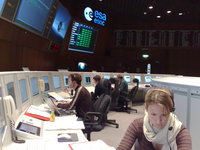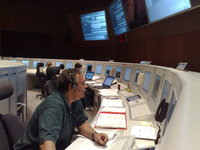How the body regulates blood pressure in response to daily stress is the focus of a study geared toward helping people whose pressure is out of control.
“Research shows that two-thirds of patients’ high blood pressure is not controlled despite the best efforts of their doctors. That is terrible,” says Dr. Gregory Harshfield, director of the Georgia Prevention Institute at the Medical College of Georgia.
“We are trying to identify the mechanisms through which blood pressure is regulated under normal everyday conditions – which is what stress is – and take that information back to the clinic to better determine what sort of therapy is going to be most effective at treating your blood pressure or your grandfather’s.”
More than a dozen researchers have teamed up to do parallel studies in animal models and young adults to learn more about what factors like genes, stress and obesity contribute, their synergy and novel ways to control them.
“This research will give us information that allows us to identify what treatment is going to be effective in what individual by genotype, by obesity and other factors. What kind of treatment is going to be effective at keeping an individual’s blood pressure down or maybe preventing it from ever getting high,” says Dr. Harshfield, principal investigator on the $10.6 million Program Project grant renewal from the National Institutes of Health’s National Heart, Lung and Blood Institute. 72 million Americans – 1 in 3 – are hypertensive, according to the NHLBI.
Studies will explore fundamentals such as why about 30 percent of young healthy blacks and 15 percent of whites can’t effectively excrete sodium, a problem that raises blood pressure by increasing the body’s fluid volume. “We think there is a defect in their kidneys, in the normal mechanisms that allow them to excrete salt,” said Dr. David Pollock, renal physiologist at MCG’s Vascular Biology Center and a program project leader. “When blood pressure goes up due to stress, their kidneys ought to get rid of more salt so their blood pressure will come down, and they don’t.”
Dr. Harshfield’s studies identified this impaired stress-induced sodium natriuresis. He believes it’s also a primary reason blood pressure remains elevated at night in some blacks, rather than dipping as it should, which keeps stressing the cardiovascular system.
Using a rat bred to be salt-sensitive, the researchers are working to identify more about the genetics of impaired sodium-handling. “We have animal model data that says the endothelin system normally functions to help your kidneys get rid of salt,” says Dr. Pollock. His studies have shown the kidney’s endothelin B receptor plays a critical role in promoting excretion of acute and chronic salt loads by activating the precursor to nitric oxide, a powerful dilator of blood vessels. In the new studies, he’ll control the rats’ diet and see whether stress slows down sodium excretion. Preliminary evidence suggests it does. He’ll also give the rats an endothelin antagonist, which blocks this hormone, and see if sodium excretion improves. He’ll also see how a high-fat diet and obesity alter the equation.
Meanwhile, for about a week, young study participants with impaired sodium excretion will take a drug to block the powerful blood vessel constrictor, angiotensin. “From our point of view, angiotensin promotes sodium retention directly and it also increases aldosterone, another hormone which promotes sodium retention,” Dr. Harshfield says. The researchers chose to study endothelin and angiotensin because they believe they work together. To explore the genetics, they’ll also look at young adults with a different version of the angiotensin receptor gene that they believe exacerbates sodium-handling problems. MCG researchers identified this genetic variation in people who retain sodium; blocking the receptor gene will provide more evidence about the importance of angiotensin, says Dr. Harshfield.
They’ll mimic the way many people work – an hour of stress, a few minutes of relief, then back to stress – by getting the young people to play competitive video games, then measuring how gene blockers affect sodium excretion. “Ultimately, you want to know how to treat people with this variation,” Dr. Harshfield says. “There is still a need to figure out why some people respond to some therapies and other don’t,” adds Dr. Pollock. “That is not our specific question but these studies will help address that. We have to identify what is it about different individuals that make them react more to stress, makes them retain more salt.”
Obesity, which is associated with increased blood pressure reactivity, is probably a differentiator, Dr. Pollock says. Fat cells actually secrete angiotensin, which gets into the bloodstream. “We are arguing in our study that you might want to treat patients differently depending on whether or not they are obese. The angiotensin receptor blocker may be more effective in obese individuals who have angiotensin falling out into their bloodstream,” says Dr. Harshfield. Consequently they’ll also compare the effectiveness of the blocker in obese and normal-weight individuals with impaired sodium excretion.
Another project is exploring the role of oxidative stress, or reactive oxygen species, in raising blood pressure. In an animal model genetically predisposed to salt-sensitive hypertension, Dr. Jennifer Pollock, biochemist in MCG’s Vascular Biology Center and a program project leader, has shown a prolonged recovery to normal blood pressure following stress. She’s also found oxidative stress levels go up with stress. Oxidative stress, or reactive oxygen species, helps make normal chemical reactions in the body but, in excess, can cause havoc. In fact, when she gives the rats an antioxidant before a stressor, blood pressure doesn’t rise as high and recovery is more normal. “We also found out that endothelin actually is the stimulus for increasing reactive oxygen species,” Dr. Jennifer Pollock says. “When we gave the rats a specific type of endothelin blocker, that also blocked the increase in oxidative stress, blocked the blood pressure increase and improved recovery.”
Now they want to know the specific sources of the reactive oxygen species. Earlier work by Dr. Frank Treiber, MCG vice president for research and principal investigator on the original Program Project grant in 2002, has shown increased blood pressure reactivity in children who are obese and/or have low socioeconomic status.
Looking at how obesity weighs in, Dr. Jennifer Pollock also is putting the rats on high-fat diets. It’s known these rats become hypertensive on a high-salt or high-fat diet and they’ve found that, as with people, fat also increases blood pressure reactivity. Now she is going to find out how.
Another animal model is providing insight into the impact of early life stressors or low socioeconomic status on cardiovascular disease. Research again found that, as with people, these animals have normal blood pressure as pups. But as stressed adult rats, they have higher pressure increases and a delayed recovery unless they are missing an endothelin receptor gene. “It cures it,” says Dr. Jennifer Pollock. “This early life stressor is being mediated through the endothelin pathway.” Her postdoctoral fellow, Dr. Analia Loria, found these early life stressor models also have more constrictive blood vessels because they are more sensitive to angiotensin. New studies will further test the endothelin connection and see if a high-fat diet makes things worse by increasing oxidative stress.
Wildlife biologists have found naturally occurring models. Rat pups whose mother builds a nest far from a food source and so must be gone foraging several hours each day, are more anxious. Neurobiologists have shown animals separated from their moms for long periods can’t run through mazes well and tend to back off in competition for food, Dr. Jennifer Pollock says. “We took that to mean their blood pressure could also be hyper reactive. Sure enough, that is what we found.”
“This has a lot of implications for earlier detection of risk-increasing environmental exposures and what you can do about it,” says Dr. Treiber, a clinical child psychologist and program project leader. “If you can’t alter the environment that quickly in life, you know now where they are headed and maybe you can preempt it pharmacogenetically.”
In the diverse group of some 600 young people he’s been following for 17 years, Dr. Treiber has found that, as with the general population, some already are obese and/or hypertensive at the average age of 25. He’ll continue to follow and annually assess them over the next five years in an effort to better understand how stress contributes to hypertension. “What we are doing is looking at chronic environmental stress in combination with some bad candidate genes that are stress activated,” says Dr. Treiber. He’s thinking that, as with rats, genetic predisposition and stress can doom people with normal pressures to hypertension. They’ll look at blood pressure reactivity, recovery, sodium secretion, measure the footprints left by oxidative stress and the levels of the stress hormone cortisol. They’ll look at early indicators of cardiovascular disease, such as enlargement of the pumping chamber of the heart and signs of carotid artery disease. “If you have a tendency to have high blood pressure or if you are obese, we can see the inner layer of the carotid getting thicker than normal people your age,” says Dr. Gaston Kapuku, cardiologist and cardiovascular researcher at the Georgia Prevention Institute and a project core leader.
America’s current obesity and type 2 diabetes epidemic also has them looking at insulin, glucose and cholesterol levels and whether fat exacerbates all the factors they are following, which they believe it does.
One reason the Georgia Prevention Institute was founded was to identify risk factors for cardiovascular disease, says Dr. Harshfield. In his 10 years at the institute, the agenda has shifted from looking at precursor development of adult hypertension to identifying mechanisms causing pediatric hypertension, a disease that didn’t exist when most hypertension textbooks were written, he says.
“Our ultimate goal, of course, is prevention,” he says. “But when we can’t do that, we want to give physicians ways to determine precisely the cause or causes of your hypertension and optimal ways to target your disease.”
The MCG Department of Biostatistics, chaired by Dr. Varghese George, is designing the studies for the Program Project grant to ensure scientifically validity and managing data for all the program projects.




































